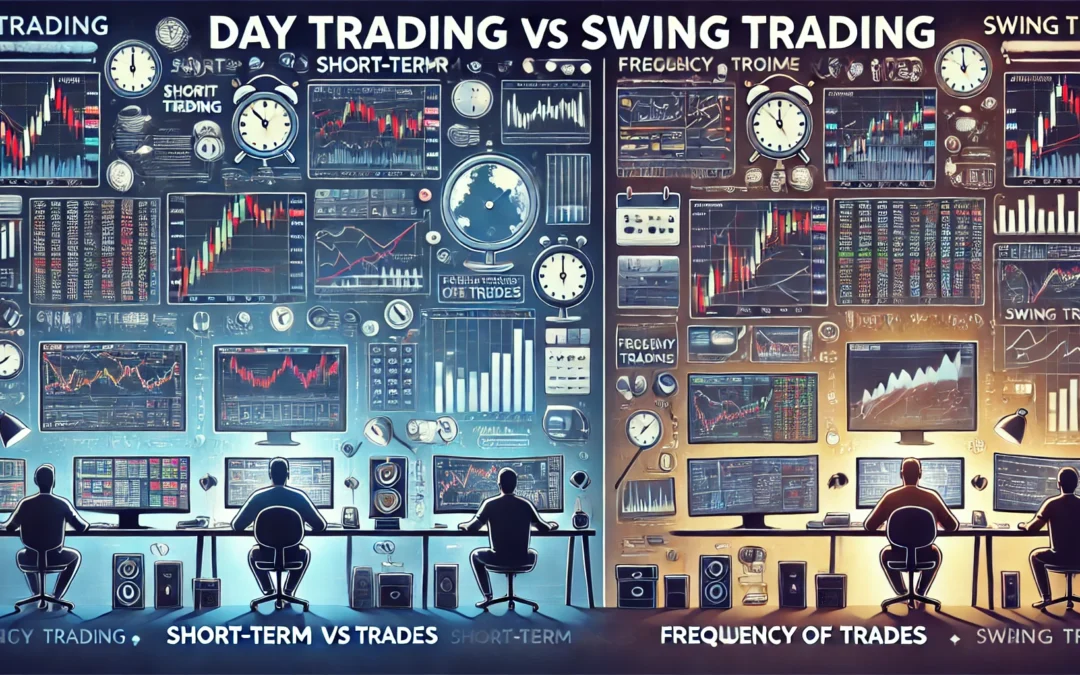Day Trading vs. Swing Trading in Forex: Which Is Right for You?
Introduction
In the dynamic world of forex trading, choosing the right trading style can significantly impact your success. Two popular trading strategies are day trading and swing trading, each with its own set of characteristics, advantages, and challenges. Understanding the differences between these approaches will help you select the one that aligns best with your goals, risk tolerance, and lifestyle. This article delves into day trading and swing trading in forex, examining their key features, benefits, and drawbacks to help you decide which is right for you.
Understanding Day Trading
What is Day Trading?
Day trading involves buying and selling forex pairs within the same trading day, with the goal of capitalizing on short-term price movements. Day traders typically close all their positions before the market closes to avoid overnight risk.
Key Characteristics
- Short Holding Period: Trades are opened and closed within the same day, sometimes within minutes or hours.
- High Frequency: Day traders execute multiple trades per day, seeking small but frequent profits.
- Technical Analysis: Emphasis on technical analysis, including charts and indicators, to identify trading opportunities.
- Leverage: Often use high leverage to amplify short-term price movements and maximize returns.
Advantages
- Quick Returns: Potential for rapid profits from short-term price movements.
- No Overnight Risk: Positions are closed by the end of the day, avoiding exposure to overnight market risks.
- High Liquidity: Can take advantage of high liquidity and market volatility throughout the trading day.
Disadvantages
- Time-Consuming: Requires constant monitoring of the market and quick decision-making, which can be demanding.
- High Stress: The fast-paced nature of day trading can be stressful and emotionally taxing.
- Higher Transaction Costs: Frequent trading leads to increased transaction costs, which can erode profits.
Ideal For
- Traders who can dedicate significant time to the markets during trading hours.
- Those who thrive in a fast-paced, high-pressure environment.
- Individuals comfortable with high leverage and frequent trading.
Understanding Swing Trading
What is Swing Trading?
Swing trading involves holding positions for several days to weeks, aiming to capture short- to medium-term price movements. Swing traders seek to profit from price “swings” or trends that occur over a longer period than day trading.
Key Characteristics
- Longer Holding Period: Trades are held from several days to weeks, depending on the market trend and strategy.
- Lower Frequency: Fewer trades are executed compared to day trading, focusing on capturing larger price movements.
- Technical and Fundamental Analysis: Utilizes both technical analysis and fundamental analysis to identify trade opportunities.
- Moderate Leverage: Typically use lower leverage compared to day traders, as trades are held for a longer period.
Advantages
- Less Time-Intensive: Requires less time monitoring the markets daily, as trades are held for longer periods.
- Reduced Stress: Lower frequency of trades and longer holding periods can lead to reduced stress compared to day trading.
- Potential for Larger Profits: Can capture larger price movements over days or weeks, potentially resulting in higher profits.
Disadvantages
- Overnight Risk: Positions are held overnight, exposing traders to potential market risks and news events.
- Longer Waiting Period: May require more patience and discipline to wait for trades to develop and reach their targets.
- Possible Missed Opportunities: Longer holding periods might mean missing out on short-term trading opportunities.
Ideal For
- Traders who prefer a less time-intensive approach and can hold positions for several days or weeks.
- Those who are comfortable with moderate leverage and less frequent trading.
- Individuals who can remain patient and disciplined in waiting for trade setups and market trends.
Comparing Day Trading and Swing Trading
Time Commitment
- Day Trading: Requires significant time and attention throughout the trading day.
- Swing Trading: Requires less daily monitoring and can be suited for traders with other commitments.
Risk and Reward
- Day Trading: Higher risk due to leverage and market volatility but offers quick returns.
- Swing Trading: Lower risk compared to day trading due to less frequent trading and reduced leverage, with potential for larger profits.
Stress Level
- Day Trading: Often more stressful due to rapid decision-making and market monitoring.
- Swing Trading: Typically less stressful with fewer trades and longer holding periods.
Costs
- Day Trading: Higher transaction costs due to frequent trading.
- Swing Trading: Lower transaction costs due to fewer trades.
Making the Right Choice
Choosing between day trading and swing trading depends on various factors, including your personal preferences, risk tolerance, and lifestyle. Here are some considerations to help you decide:
- Time Availability: If you can dedicate significant time to trading and thrive in a fast-paced environment, day trading might be suitable. If you prefer a less time-intensive approach, swing trading may be a better fit.
- Risk Tolerance: Assess your comfort level with leverage and market volatility. Day trading involves higher risk and leverage, while swing trading typically involves lower leverage and reduced risk.
- Profit Goals: Consider your profit objectives and trading style. Day trading aims for quick profits from small price movements, while swing trading seeks larger profits from medium-term trends.
Conclusion
Both day trading and swing trading offer unique opportunities and challenges in the forex market. Day trading is suited for those who can commit to constant market monitoring and are comfortable with high leverage and frequent trades. In contrast, swing trading is ideal for those who prefer a less time-intensive approach, can hold positions for several days or weeks, and are willing to be patient in capturing larger price movements.
Ultimately, the choice between day trading and swing trading depends on your individual preferences, trading goals, and lifestyle. By understanding the characteristics, advantages, and drawbacks of each approach, you can make an informed decision and develop a trading strategy that aligns with your needs and objectives.
4o mini

